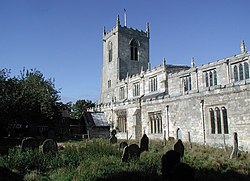Eastrington
| Eastrington | |
| Yorkshire East Riding | |
|---|---|
 St Michael's church, Eastrington | |
| Location | |
| Grid reference: | SE796299 |
| Location: | 53°45’36"N, 0°47’37"W |
| Data | |
| Population: | 1,147 (2011) |
| Post town: | Goole |
| Postcode: | DN14 |
| Dialling code: | 01430 |
| Local Government | |
| Council: | East Riding of Yorkshire |
| Parliamentary constituency: |
Haltemprice and Howden |
Eastrington is a small village within the old Liberty of Howdenshire in the East Riding of Yorkshire. It is found three miles east of Howden and 17 miles south-east of the county town, York.
The wider civil parish includes Eastrington itself and such hamlets as Newland, Owsthorpe and Portington. The 2011 census recorded a parish population of 1,147.
The village is served by Eastrington railway station (formerly "South Eastrington") on the Hull to Selby railway line, and was historically also served by North Eastrington railway station on the Hull and Barnsley Railway.[1]
St Michael's Church
St Michael's Church, Eastrington is at the centre of the village. A church at Eastrington is mentioned in the 1086 Domesday Book, listed as part of the Howden manor, and in 1146 Eastrington was specifically mentioned as a chapel of Howden.
Architecturally the church is a mixture of historical influences. The present chancel was probably in the original chapel. The walls are Norman with chamfered string courses both inside and out, as are the carved stone inside the building, steps on which the font stands and the gargoyles. Surviving records from accounts at Durham suggest that monks paid for some of the early mediæval building work, while the north and south aisles were later additions and probably paid for by three local families - the Askes, Kayvills (or Cavilles) and Portingtons. In the Portington chapel, a "coffin shaped cross slab with lead filled design" can be found on the floor dated from the early 13th century, also a second cross slab carved in relief, dated from the late 13th century. There is a shield below the cross head, possibly of the Caville arms.
Architectural evidence suggests that much of St Michael's Church building surviving today was built during the 14th century. The windows of the chapel are typical of the 14th century and a tombstone recorded as being in the church in 1584 was inscribed with the words "Orate pro animabus Nicholai de Portington, militis, qui istam capellam fieri fecit" (Pray for the soul of Nicholas Portington, knight, who caused this chapel to be built). It is thought to be that of Nicholas Portington who was still alive in 1327.
The church is a Grade I listed building.[2]
History
In 1823 the village is noted by Baines in his History, Directory and Gazetteer of the County of York. The King was the patron of Eastrington's Church of St Michael. A Methodist chapel and a free school existed. The village had a population of 375, with occupations including six carpenters, four farmers, two shopkeepers, a shoemaker, a blacksmith, a corn miller, a tailor, and the landlord of the Bay Horse public house. Also directory-listed was a school master and a yeoman.[3]
About the village
There is one pub in Eastrington, the Black Swan.
Nearby are Eastrington Ponds, a local nature reserve.
Outside links
| ("Wikimedia Commons" has material about Eastrington) |
- Eastrington in the Domesday Book
References
- ↑ Butt, R. V. J. (1995). The Directory of Railway Stations: details every public and private passenger station, halt, platform and stopping place, past and present (1st ed.). Sparkford: Patrick Stephens Ltd. ISBN 978-1-85260-508-7. OCLC 60251199.
- ↑ National Heritage List 1031835: Church of St Michael (Grade I listing)
- ↑ Baines, Edward (1823). History, Directory and Gazetteer of the County of York. p. 200.
- Gazetteer — A–Z of Towns Villages and Hamlets. East Riding of Yorkshire Council. 2006. p. 5.

